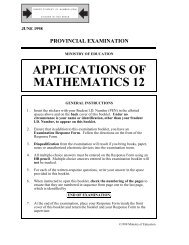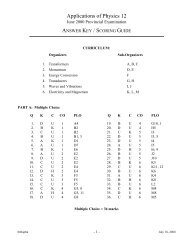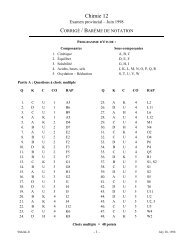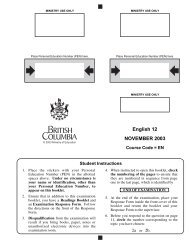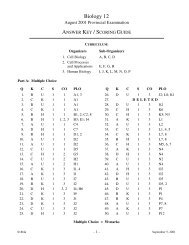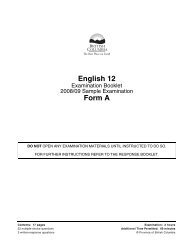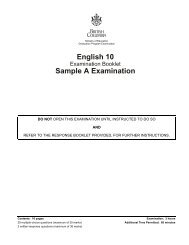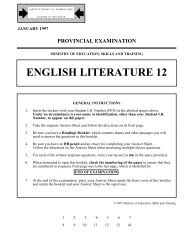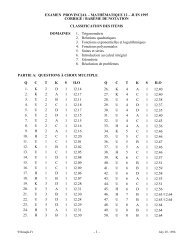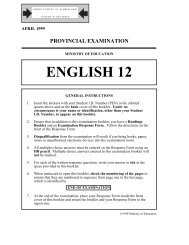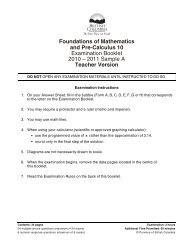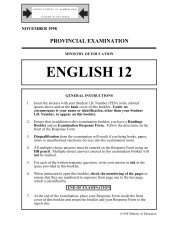english 12 readings booklet - QuestionBank.CA
english 12 readings booklet - QuestionBank.CA
english 12 readings booklet - QuestionBank.CA
You also want an ePaper? Increase the reach of your titles
YUMPU automatically turns print PDFs into web optimized ePapers that Google loves.
INSERT STUDENT I.D. NUMBER (PEN)<br />
STICKER IN THIS SPACE<br />
JANUARY 1999<br />
PROVINCIAL EXAMINATION<br />
MINISTRY OF EDU<strong>CA</strong>TION<br />
ENGLISH <strong>12</strong><br />
GENERAL INSTRUCTIONS<br />
1. Insert the stickers with your Student I.D. Number (PEN) in the allotted<br />
spaces above and on the back cover of this <strong>booklet</strong>. Under no<br />
circumstance is your name or identification, other than your Student<br />
I.D. Number, to appear on this <strong>booklet</strong>.<br />
2. Ensure that in addition to this examination <strong>booklet</strong>, you have a Readings<br />
Booklet and an Examination Response Form. Follow the directions on the<br />
front of the Response Form.<br />
3. Disqualification from the examination will result if you bring books, paper,<br />
notes or unauthorized electronic devices into the examination room.<br />
4. All multiple-choice answers must be entered on the Response Form using an<br />
HB pencil. Multiple-choice answers entered in this examination <strong>booklet</strong> will<br />
not be marked.<br />
5. For each of the written-response questions, write your answer in ink in the<br />
space provided in this <strong>booklet</strong>.<br />
6. When instructed to open this <strong>booklet</strong>, check the numbering of the pages to<br />
ensure that they are numbered in sequence from page one to the last page,<br />
which is identified by<br />
END OF EXAMINATION .<br />
7. At the end of the examination, place your Response Form inside the front<br />
cover of this <strong>booklet</strong> and return the <strong>booklet</strong> and your Response Form to the<br />
supervisor.<br />
©1999 Ministry of Education
THIS PAGE INTENTIONALLY BLANK
ENGLISH <strong>12</strong> PROVINCIAL EXAMINATION<br />
Value<br />
Suggested<br />
Time<br />
1. This examination consists of five parts:<br />
PART A: Editing Skills 10 10<br />
PART B: Reading Comprehension 21 35<br />
PART C: Poetry 20 30<br />
PART D: Prose 25 50<br />
PART E: Composition 24 55<br />
Total: 100 marks 180 minutes<br />
2. Electronic devices, including dictionaries and pagers, are not permitted in the examination<br />
room.<br />
3. The Readings Booklet contains the prose and poetry passages you will need to answer certain<br />
questions on this examination.<br />
4. The time allotted for this examination is three hours. Use your time wisely. Adequate writing<br />
space has been provided for average-sized writing. Do not attempt to determine the length of<br />
your answers by the amount of writing space available.<br />
- 1 -<br />
OVER
PART A: EDITING SKILLS<br />
Total Value: 10 marks<br />
Suggested Time: 10 minutes<br />
INSTRUCTIONS:<br />
The following passage has been divided into numbered sentences which may<br />
contain problems in grammar, usage, word choice, spelling, or punctuation. One or<br />
more sentences may be correct. No sentence contains more than one error.<br />
If you find an error, select the underlined part that must be changed in order to make<br />
the sentence correct and record your choice on the Response Form provided. Using<br />
an HB pencil, completely fill in the circle that corresponds to your answer. If there<br />
is no error, completely fill in circle D (no error).<br />
SLOPES OF GOLD<br />
1. The skiing industry in British Columbia is booming! Because each winter both<br />
(A)<br />
skiers and snowboarders flock to their local hills to enjoy the<br />
(B)<br />
adrenaline rush of cruising the slopes.<br />
(C)<br />
(D) no error<br />
2. Throughout the entire province, its estimated that approximately 35 million<br />
(A)<br />
dollars is spent annually on lift-tickets, and millions more on the<br />
(B)<br />
acquisition of new ski equipment.<br />
(C)<br />
(D) no error<br />
3. In the Vancouver area and on Vancouver Island, the larger resorts<br />
(A)<br />
catered to local skiers as well as to thousands of tourists from<br />
(B)<br />
Japan and Europe who travel to BC to enjoy the world famous slopes.<br />
(C)<br />
(D) no error<br />
4. These tourists, many of who will spend thousands of dollars<br />
(A)<br />
on a single trip, help support different businesses in the province.<br />
(B)<br />
(C)<br />
(D) no error<br />
- 2 -
5. Many small communities throughout the interior of the province<br />
(A)<br />
also rely heavily on this tourist trade to bolster their local winter economies.<br />
(B)<br />
(C)<br />
(D) no error<br />
6. Because of their small town atmospheres and fabulous snow conditions these<br />
(A)<br />
delightfully quaint communities attract skiers and snowboarders to their recreation<br />
(B)<br />
venues nestled among the mountains.<br />
(C)<br />
(D) no error<br />
7. All of the ski resorts offer the following full service facilities for skiers: groomed<br />
(A)<br />
(B)<br />
runs, multiple chair lifts, and you can even get infant daycare services.<br />
(C)<br />
(D) no error<br />
8. Each of the resorts also provide skiing and snowboarding<br />
(A)<br />
lessons by certified instructors for enthusiasts of varying performance levels.<br />
(B)<br />
(C)<br />
(D) no error<br />
9. Pat Kelly, a young skiing instructor at Whistler, BC, says, “the skiing industry is<br />
(A)<br />
booming and by the year 2000, the industry should triple! This will create at<br />
(B)<br />
least another 400 jobs in the community of Whistler alone.”<br />
(C)<br />
(D) no error<br />
10. So this year when the snow arrives, many resort owners will see “golden” flakes<br />
(A)<br />
falling from the heavens; as they once again prepare for the hordes of skiers.<br />
(B)<br />
(C)<br />
(D) no error<br />
- 3 -<br />
OVER
PART B: READING COMPREHENSION<br />
Total Value: 21 marks<br />
Suggested Time: 35 minutes<br />
INSTRUCTIONS:<br />
Read “Herbal Remedies: Buyers Beware” on pages 1 to 3 in the Readings Booklet.<br />
Select the best answer for each question and record your choice on the Response<br />
Form provided.<br />
11. In paragraph 3, the phrase “gave it a whirl” is an example of<br />
A. a pun.<br />
B. jargon.<br />
C. an idiom.<br />
D. a euphemism.<br />
<strong>12</strong>. According to paragraphs 6 to 11, the use of herbal remedies in Canada is under question<br />
because of<br />
A. a lack of regulations.<br />
B. government taxation.<br />
C. ineffective marketing.<br />
D. consistent results in their use.<br />
13. In paragraph 7, “unwittingly” means without<br />
A. care.<br />
B. humour.<br />
C. prejudice.<br />
D. knowledge.<br />
14. In paragraph 8, the phrase “crap shoot” suggests that buying herbal remedies is<br />
A. illegal.<br />
B. a risky proposition.<br />
C. conventional practice.<br />
D. not to be taken seriously.<br />
15. According to paragraph 14, any skepticism of herbal remedies by modern medicine could be<br />
considered<br />
A. ironic.<br />
B. folkloric.<br />
C. sarcastic.<br />
D. scientific.<br />
- 4 -
16. According to paragraph 17, the primary difference between modern pharmacology and herbal<br />
remedies is that modern medicines<br />
A. vary in potency.<br />
B. react inconsistently.<br />
C. are no longer tested.<br />
D. contain standardized ingredients.<br />
17. According to the article, herbal remedies are natural products that<br />
A. may be dangerous.<br />
B. are not sold in pharmacies.<br />
C. pose no danger if overdosed.<br />
D. are more expensive than conventional medicines.<br />
18. According to paragraph 29, most of the Canadian federal government’s enforcement of herbal<br />
remedies concentrates on<br />
A. retail and taxation issues.<br />
B. statistical documentation of ill effects.<br />
C. classification and identification of herbs.<br />
D. manufacturing, distribution, and importation.<br />
19. In paragraph 32, the phrase “anecdotal evidence” means<br />
A. culture specific.<br />
B. whimsical stories.<br />
C. personal testimony.<br />
D. scientifically proven.<br />
20. The main idea from this passage is summarized best in<br />
A. paragraph 1.<br />
B. paragraph 6.<br />
C. paragraph 14.<br />
D. paragraph 33.<br />
21. In the passage, the author favours<br />
A. the safe use of herbal remedies.<br />
B. relaxed regulations for herbal remedies.<br />
C. the increased use of imported medicines.<br />
D. the exclusive use of conventional medicines.<br />
- 5 -<br />
OVER
Herbal Remedies: Buyers Beware<br />
(pages 1 to 3 in the Readings Booklet)<br />
INSTRUCTIONS:<br />
Use the space provided in this <strong>booklet</strong> for written-response questions. Write your<br />
answers in ink. You may quote or paraphrase. Complete sentences are not<br />
required in this section.<br />
1. From paragraphs 1 to <strong>12</strong>, identify two stylistic devices or techniques used by the author to<br />
support his argument and quote an example of each. (No mark awarded for providing a<br />
device/technique or a quotation only.)<br />
a) Device:<br />
Example:<br />
(2 marks)<br />
b) Device:<br />
Example:<br />
(2 marks)<br />
2. This article suggests that the herbal industry may have a credibility problem. From paragraphs<br />
13 to 20, state two reasons for this credibility problem and provide a supporting quotation for<br />
each.<br />
a) Reason:<br />
Supporting quotation:<br />
(2 marks)<br />
b) Reason:<br />
Supporting quotation:<br />
(2 marks)<br />
- 6 -
3. From paragraphs 33 to 35, state two reasons why the author believes that Germany has the right<br />
approach to regulating herbal remedies.<br />
a)<br />
(1 mark)<br />
b)<br />
(1 mark)<br />
- 7 -<br />
OVER
Total Value: 20 marks<br />
PART C: POETRY<br />
Suggested Time: 30 minutes<br />
INSTRUCTIONS:<br />
Read the poem “Station” on pages 4 and 5 in the Readings Booklet. Select the best<br />
answer for each question and record your choice on the Response Form provided.<br />
22. Lines 11 and <strong>12</strong>, “…entering into the light / of the world,” suggest<br />
A. death.<br />
B. the city.<br />
C. the past.<br />
D. the future.<br />
23. The son is going to<br />
A. live on his own.<br />
B. join the military.<br />
C. live with his mother.<br />
D. attend boarding school.<br />
24. Lines 28 to 30, “What ails our heart? Mine / aching in vain for the words / to make sense of<br />
our life together,” reveal that the speaker is<br />
A. angry.<br />
B. doubtful.<br />
C. resentful.<br />
D. distraught.<br />
25. Lines 32 and 33, “of my finding the words, feathered syllables / fidgeting in his throat,” contain<br />
an example of<br />
A. alliteration.<br />
B. dissonance.<br />
C. onomatopoeia.<br />
D. rhyming couplet.<br />
26. Lines 34 and 35, “In a sudden rush of bodies / and announcements out of the air…,” indicate<br />
that the<br />
A. train has just arrived.<br />
B. train is about to leave.<br />
C. father is leaving the son.<br />
D. father is changing his mind.<br />
- 8 -
27. In line 39, “shackles” implies<br />
A. wisdom.<br />
B. freedom.<br />
C. captivity.<br />
D. movement.<br />
28. In addition to its literal meaning, the title suggests<br />
A. social status.<br />
B. a lack of purpose.<br />
C. a stage in one’s life.<br />
D. a lack of movement.<br />
29. The poem is predominantly<br />
A. didactic.<br />
B. dramatic.<br />
C. narrative.<br />
D. expository.<br />
- 9 -<br />
OVER
Station<br />
(pages 4 and 5 in the Readings Booklet)<br />
INSTRUCTIONS:<br />
In paragraph form, answer questions 4 and 5 in the space provided. Write in ink.<br />
The mark for your answer will be based on the appropriateness of the example(s)<br />
you use as well as the adequacy of your explanation and the quality of your written<br />
expression.<br />
4. In paragraph form and with reference to the poem, discuss the poet’s use of contrast between<br />
light and dark to illustrate the father’s mixed feelings.<br />
(6 marks)<br />
- 10 -
5. In paragraph form and with reference to the poem, explain what the train symbolizes.(6 marks)<br />
- 11 -<br />
OVER
Total Value: 25 marks<br />
PART D: PROSE<br />
Suggested Time: 50 minutes<br />
INSTRUCTIONS:<br />
Read the story entitled “Hindspring” on pages 6 to 9 in the Readings Booklet.<br />
Select the best answer for each question and record your choice on the Response<br />
Form provided.<br />
30. In paragraph 1, “A howling, a yaffling, a baying” is an example of<br />
A. simile.<br />
B. hyperbole.<br />
C. alliteration.<br />
D. onomatopoeia.<br />
31. In paragraph 16, “guile” means<br />
A. guilt.<br />
B. deceit.<br />
C. caution.<br />
D. manners.<br />
32. In paragraph 18, Emily’s eyes are “brilliant,” showing that she is<br />
A. angry.<br />
B. excited.<br />
C. frightened.<br />
D. intelligent.<br />
33. In paragraph 35, the phrase “Emily tosses her golden mane” is an example of<br />
A. allusion.<br />
B. metaphor.<br />
C. apostrophe.<br />
D. personification.<br />
34. Emily may follow Jim’s suggestion to sell the story in order to<br />
A. reward Jim.<br />
B. save the hind.<br />
C. help end these hunts.<br />
D. help further Jim’s career.<br />
- <strong>12</strong> -
35. In the story, the primary antagonist is<br />
A. Jim.<br />
B. the deer.<br />
C. the hunters.<br />
D. the reporters.<br />
36. The point of view of the story is<br />
A. objective.<br />
B. omniscient.<br />
C. first person.<br />
D. limited omniscient.<br />
- 13 -<br />
OVER
Hindspring<br />
(pages 6 to 9 in the Readings Booklet)<br />
INSTRUCTIONS:<br />
In paragraph form, answer questions 6 to 8 in the space provided. Write in ink.<br />
The mark for your answer will be based on the appropriateness of the example(s)<br />
you use as well as the adequacy of your explanation and the quality of your written<br />
expression.<br />
6. In paragraph form and with reference to paragraphs 1 to 10, explain how the author uses<br />
imagery to create atmosphere.<br />
(6 marks)<br />
- 14 -
7. In paragraph form and with reference to the story, discuss the character of Emily. (6 marks)<br />
- 15 -<br />
OVER
8. In paragraph form and with reference to the story, explain how conflict plays an important role<br />
in the story.<br />
(6 marks)<br />
- 16 -
Value: 24 marks<br />
PART E: COMPOSITION<br />
Suggested Time: 55 minutes<br />
INSTRUCTIONS:<br />
Using standard English, write a coherent, unified, multi-paragraph composition of<br />
300-500 words on the topic below. In your composition, you may apply any<br />
effective and appropriate method of development which includes any combination<br />
of exposition, persuasion, description, and narration.<br />
Use the page headed Organization and Planning for your rough work. Write your<br />
composition in ink on the pages headed Finished Work.<br />
9. Write a multi-paragraph composition on the topic below. Your response may draw upon any<br />
aspect of your life: your reading, your own experiences, the experiences of others, and so on.<br />
Topic:<br />
Making Commitments<br />
- 17 -<br />
OVER
Organization and Planning<br />
- 18 -
FINISHED WORK<br />
Topic: Making Commitments<br />
- 19 -<br />
OVER
FINISHED WORK<br />
- 20 -
FINISHED WORK<br />
- 21 -<br />
OVER
FINISHED WORK<br />
END OF EXAMINATION<br />
1st<br />
SUBTOTAL<br />
2nd<br />
- 22 -
|<br />
|<br />
|<br />
|<br />
|<br />
|<br />
|<br />
|<br />
|<br />
|<br />
|<br />
|<br />
|<br />
|<br />
|<br />
|<br />
|<br />
|<br />
|<br />
|<br />
|<br />
|<br />
|<br />
|<br />
|<br />
|<br />
|<br />
|<br />
|<br />
|<br />
|<br />
|<br />
|<br />
|<br />
|<br />
|<br />
|<br />
|<br />
|<br />
|<br />
|<br />
|<br />
|<br />
|<br />
|<br />
|<br />
|<br />
|<br />
|<br />
|<br />
|<br />
|<br />
|<br />
|<br />
|<br />
|<br />
|<br />
|<br />
|<br />
|
INSERT STUDENT I.D. NUMBER (PEN)<br />
STICKER IN THIS SPACE<br />
ENGLISH <strong>12</strong><br />
January 1999<br />
Course Code = EN
FOR OFFICE USE ONLY<br />
ENGLISH <strong>12</strong><br />
January 1999<br />
Course Code = EN<br />
Score for<br />
Question 1:<br />
1. _____<br />
(4)<br />
Score for<br />
Question 2:<br />
2. _____<br />
(4)<br />
Score for<br />
Question 3:<br />
3. _____<br />
(2)<br />
Score for<br />
Question 8:<br />
8. _____<br />
(6)<br />
Score for<br />
Question 9:<br />
9. _____<br />
(24)<br />
Score for<br />
Question 4:<br />
4. _____<br />
(6)<br />
Score for<br />
Question 5:<br />
5. _____<br />
(6)<br />
Score for<br />
Question 6:<br />
6. _____<br />
(6)<br />
Score for<br />
Question 7:<br />
7. _____<br />
(6)
ENGLISH <strong>12</strong><br />
READINGS BOOKLET<br />
JANUARY 1999<br />
©1999 Ministry of Education
THIS PAGE INTENTIONALLY BLANK
PART B: READING COMPREHENSION<br />
INSTRUCTIONS:<br />
Read the following passage and answer the questions on pages 4 to 7 in the<br />
examination <strong>booklet</strong>.<br />
adapted from Herbal Remedies: Buyers Beware<br />
by Paul Taylor<br />
REMOVED DUE TO COPYRIGHT RESTRICTIONS<br />
- 1 -<br />
OVER
REMOVED DUE TO COPYRIGHT RESTRICTIONS<br />
- 2 -
REMOVED DUE TO COPYRIGHT RESTRICTIONS<br />
- 3 -
PART C: POETRY<br />
INSTRUCTIONS:<br />
Read the following poem and answer the questions on pages 8 to 11 in the<br />
examination <strong>booklet</strong>.<br />
Station<br />
by Eamon Grennan<br />
1<br />
5<br />
10<br />
15<br />
20<br />
25<br />
30<br />
We are saying goodbye<br />
on the platform. In silence<br />
the huge train waits, crowding the station<br />
with aftermath and longing<br />
and all we’ve never said<br />
to one another. He<br />
shoulders his black bag and shifts<br />
from foot to foot, restless to be off, his eyes<br />
wandering over tinted windows where he’ll sit<br />
staring out at the Hudson’s 1 platinum dazzle.<br />
I want to tell him he’s entering into the light<br />
of the world, but it feels like a long tunnel<br />
as he leaves one home, one parent<br />
for another,<br />
and we both know it won’t ever<br />
be the same again. What is the air at,<br />
heaping between us, then thinning<br />
to nothing? Or those slategrey birds that<br />
croon to themselves in an iron angle, then<br />
take flight, inscribing<br />
huge loops of effortless grace<br />
between this station of shade and the shining water?<br />
When our cheeks rest glancing against each other,<br />
I can feel mine scratchy with beard and stubble, his<br />
not quite smooth as a girl’s, harder, a faint fuzz<br />
starting—those silken beginnings I can see<br />
when the light is right, his next life<br />
in bright first touches. What ails our heart? Mine<br />
aching in vain for the words<br />
to make sense of our life together, his<br />
fluttering in dread<br />
of my finding the words, feathered syllables<br />
fidgeting in his throat.<br />
1 Hudson: Hudson River<br />
- 4 -
35<br />
40<br />
45<br />
In a sudden rush of bodies<br />
and announcements out of the air, he says<br />
he’s got to be going. One quick touch<br />
and he’s gone. In a minute<br />
the train—ghostly faces behind smoked glass—<br />
groans away on wheels and shackles, a slow glide<br />
I walk beside, waving<br />
at what I can see no longer. Later,<br />
on his own in the city, he’ll enter the underground<br />
and cross the river, going home<br />
to his mother’s house: I imagine that white face<br />
carried along in the dark glass, shining<br />
through shadows that fill the window<br />
and fall away again<br />
before we’re even able to name them.<br />
- 5 -
PART D: PROSE<br />
INSTRUCTIONS:<br />
Read the following selection and answer the questions on pages <strong>12</strong> to 16 in the<br />
examination <strong>booklet</strong>.<br />
Adapted from Hindspring<br />
by Margaret Drabble<br />
Emily Palmer is sent by her family to check the house of her missing grandmother, Frieda, in<br />
Exmoor (England). She stays the night in her grandmother’s house.<br />
1 When she wakes, it is already mid-morning. In the far distance she can hear a strange howling, as<br />
of wild animals. She opens the tall deep windows and leans out over the low ledge to listen. A<br />
howling, a yaffling, a baying.<br />
2 As she carefully descends the rotten stairs to go down to load the car, the howling and baying are<br />
nearer and there are other curious, unexpected noises—can that be the blowing of horns, and the<br />
hoofs of horses, and the grinding of gears? Suddenly the whole landscape is alive around her, as<br />
turbulence gathers about her, rushes towards her, thunders and crashes towards her and the house.<br />
She runs into the big front ground-floor room where she had slept, where the large window still<br />
stands open, and she sees in amazement that the whole of the hillside is pouring towards her in<br />
violent turmoil. Trees toss and bend, stones and rocks bounce and roll and splinter at her, a whole<br />
avalanche descends towards her, and just as she begins to make sense of this mighty upheaval, a<br />
red deer leaps the urned parapet, and crashes across the lawn, and clears the window-sill, and<br />
bounds into the arms of Emily Palmer.<br />
3 The hounds stream after her, and Emily dashes to bar the window, as the deer takes refuge behind<br />
the table, putting her hoof through the back of a painting, knocking a clock and an expensive glass<br />
vase to the floor. The hounds throw themselves at the window, in full cry, howling and yelping<br />
and lathering, dozens of them, or so it seems to the hind 1 and to Emily. Emily spreads her arms<br />
against the window, and screams. “Stand back, stand back!” she cries into the garden. The<br />
hounds leap, then falter, and across the lawn, hoofs cutting the grass, come the horses and the<br />
riders, steaming, angry, hot-blooded, maddened by the chase. The riders in the vanguard reign in<br />
their mounts when they see the hounds, when they see Emily at the window, but more and more<br />
horses crash down the hillside beside them through the bracken, through the rhododendrons,<br />
almost tumbling over one another in the pursuit. Soon the lawn is thick with steaming, snorting<br />
steeds and horsemen and dogs, gathered as suddenly, and as improbably, as if they had dropped<br />
from the heavens. They yelp and throng.<br />
4 The hind trembles with terror, and Emily is exultant with indignation. She is fearless. As some<br />
kind of calm obtains amongst the huntsmen, Emily opens the window and leans out.<br />
1 hind: female red deer<br />
- 6 -
5 “What are you doing?” she demands, in a voice as firm and as clear as a bell. Her hair flames with<br />
its own light, and those who were to tell the tale swore that she appeared as an avenging angel.<br />
Terror now fills the huntsmen, for who is this maiden, what is she doing here, and where is their<br />
quarry? “Away with you!” cries Emily. “This is my grandmother’s property!”<br />
6 The scene is majestic, ridiculous. The hounds are subdued, and the Master of the Staghounds<br />
approaches to offer a gallant apology. He touches his hat with his whip, he bows like a gentleman.<br />
But still he wants his deer. The house and the lawn may belong to her and her grandmother, but<br />
the hind belongs to him.<br />
7 Emily cannot believe her ears. The scene descends into bathos 2 . She is angry.<br />
8 “Are you suggesting I let this poor creature out to those murdering monsters?” she yells. “You<br />
must be mad! I’ll have you all for trespass! And get those dogs off my roof!”<br />
9 For two of the hounds in their excitement have taken the short cut, and jumped from the path<br />
above on to the guttering: now they perch nervously, not sure how they got there or how to get off<br />
again.<br />
10 “Get off, get away, get off!” repeats and exhorts Emily. “You have no right to come here, and I<br />
grant the beast sanctuary!”<br />
11 She is worried about what the beast is up to, behind her: she has heard the crashing of glass, but<br />
dare not look round to examine the damage. She must confront these intruders until they sound<br />
the retreat. She knows nothing of stag hunting, she knows neither its rules nor its seasons; she<br />
does not know that at this season of the year the hunted deer will be a female and therefore,<br />
fortunately, unantlered. But she does know that she must stand her ground. That is the role that<br />
has been given to her, and she will not betray it. She is the heroine of the chase, the protectress of<br />
the deer at bay. It is a fine role, and one she knows she looks good in: nevertheless she is<br />
surprised when a chap in helmet, lifted goggles and leathers drives his motorbike on to the lawn<br />
and into the middle of the mêlée and starts to take her photograph. The grass is a sea of mud by<br />
now, but then one couldn’t have said it was very well kept in the first place. Can the chap on the<br />
motorbike be a friend and an ally? Is he, by any happy chance, a hunt saboteur?<br />
<strong>12</strong> Not quite, it proves, but he is good enough for her purposes. He is a press photographer, and he<br />
has been following the stag hounds for an article about the League Against Cruel Sports. He<br />
cannot believe his luck. This will be the picture of the decade, of the century. It will be<br />
reproduced until there are no more hunts and no more hinds and no more hunted, until the moors<br />
and woodland are no more. Emily and the hind have made his fortune. He snaps and snaps, as<br />
Emily stands there in the window, until he realizes that other cameras are beginning to emerge<br />
from the leafage, from the woodwork; hunt followers, even hunters, appear to be equipped with all<br />
kinds of photographic apparatus, and the scene is transformed from panic and chaos into a photoopportunity,<br />
as lights flash, lenses dilate, buttons are pressed, dogs whine, horses stamp and snort.<br />
Nobody wants to miss out, but our professional photographer is not keen to share his prize, and<br />
also wakes up to the fact that he badly needs a shot of the deer indoors as well as a shot (which he<br />
hopes he has got) of it leaping in panic over the window-sill. So he runs forward and rushes across<br />
the mangled grass and the one-time herbaceous borders and yells at Emily: “Let me in! Let me<br />
in!”<br />
2 bathos: absurdity<br />
- 7 -<br />
OVER
13 Emily hesitates, takes in the features of his face, likes what she sees, and opens a pane. He<br />
scrambles over, less elegantly than the hind, which is cowering at the other end of the room<br />
immobile with shock.<br />
14 “Western Press,” says the young man, who is almost as young as Emily herself.<br />
15 “Emily Palmer,” says Emily, dazed.<br />
16 They gaze at one another, astonished. The young man lifts his camera at her, lets it fall. He is<br />
open, eager, unwary. He has learnt no guile. Is he, perhaps, the one she has been hoping to meet?<br />
17 “Sorry,” he says, apologizing for his professional reflex.<br />
18 “That’s OK,” says Emily. She is panting slightly, with excitement. Her nostrils are dilated, her<br />
colour high, her eyes brilliant.<br />
19 “Are you all right?” asks the young man.<br />
20 “I’m all right,” says Emily. “But I don’t know about him.”<br />
21 She indicates the trembling beast, at which she dares not look: she is afraid it is damaged, injured,<br />
will have to be put down.<br />
22 “Her,” says the young man. “It’s a hind.”<br />
23 The manner in which he says this convinces Emily that she has found a friend, and she bursts into<br />
tears of shock and relief.<br />
24 “A hind?” she weeps. “Do they chase hinds?”<br />
25 “You bet they do. Hinds in calf, hinds with calf. In December they only chase hinds.”<br />
26 “Is she all right?” asks Emily.<br />
27 “I’ll have a look,” says the young man. “Do you mind if I take a picture while I do it?”<br />
28 Emily is busy shutting and bolting the windows against the milling confusion of the thwarted<br />
throng. The young man kneels gently by the frightened animal, speaks to her quietly, then flashes<br />
at her. The beast jerks in alarm, then quivers into stillness.<br />
29 “Don’t do that,” says Emily.<br />
30 “Sorry,” says the young man.<br />
31 The hind seems to be in one piece, but they agree that they will have to keep her indoors until the<br />
crowd has gone. Emily says she is afraid the poor thing will die of fright, but the young man says<br />
he thinks she will recover. What next? Shall Emily go out and parley? 3<br />
32 “We’ll have to get rid of them,” says Emily. “Can’t I tell them just to get off my property?”<br />
3 parley: negotiate<br />
- 8 -
33 “Not as easy as all that,” says the young man, beginning to look around him with interest, taking in<br />
not only the beautiful maiden but also the bizarre décor of the house she inhabits. “The horses can<br />
get out, but there’s been an accident in the drive. An Isuzu’s gone over the edge and a lot of other<br />
stuff is stuck behind it. It’s a scene there, I can tell you. It’ll take hours to clear.”<br />
34 Emily is beginning to calm down, and the animal too seems less distressed. The young man (who<br />
has declared himself to be Jim from Bristol) allows her to think that he shares her anti-hunt<br />
feelings, although he had set out on the day’s chase as a neutral observer. He offers to go out and<br />
negotiate with the Master of the Staghounds, and, if Emily will permit him, on his return to take<br />
some more pictures. Emily assures him that she can deal with the Master herself, and climbs over<br />
the window-sill to do so, leaving Jim in charge of the hind. She confronts them all, boldly. She<br />
tells them roundly that they are trespassing, that she gathers they have blocked her drive, and that<br />
she is about to ring the police.<br />
35 The undifferentiated mass of black-jacketed, white-stocked, fawn-breeched, red-nosed, hair-netted,<br />
khaki-jacketed, black-booted folk begins to mumble, thin, retreat. Emily tosses her golden mane<br />
and scrambles back over her window-sill.<br />
36 Jim says it would be better to ring a national paper than the police. He wants to sell the story, and<br />
so should she. They compromise: they will ring the press, and the police, and a vet, and Emily<br />
will make them both a cup of coffee.<br />
- 9 -
ACKNOWLEDGEMENTS<br />
Drabble, Margaret. “Hindspring.” from The Witch of Exmoor. Toronto: McClelland<br />
& Stewart, Inc., 1996.<br />
The Witch of Exmoor by Margaret Drabble. Used by permission of McClelland &<br />
Stewart, Inc. The Canadian Publishers and by permission of Westwood Creative<br />
Artists.<br />
Grennan, Eamon. “Station” copyright 1998 by Eamon Grennan. Reprinted from<br />
Relations: New & Selected Poems with the permission of Graywolf Press,<br />
Saint Paul, Minnesota.<br />
Taylor, Paul. “Herbal Remedies: Buyers Beware.” The Globe and Mail.<br />
Tuesday, September 23, 1997.<br />
- 10 -



